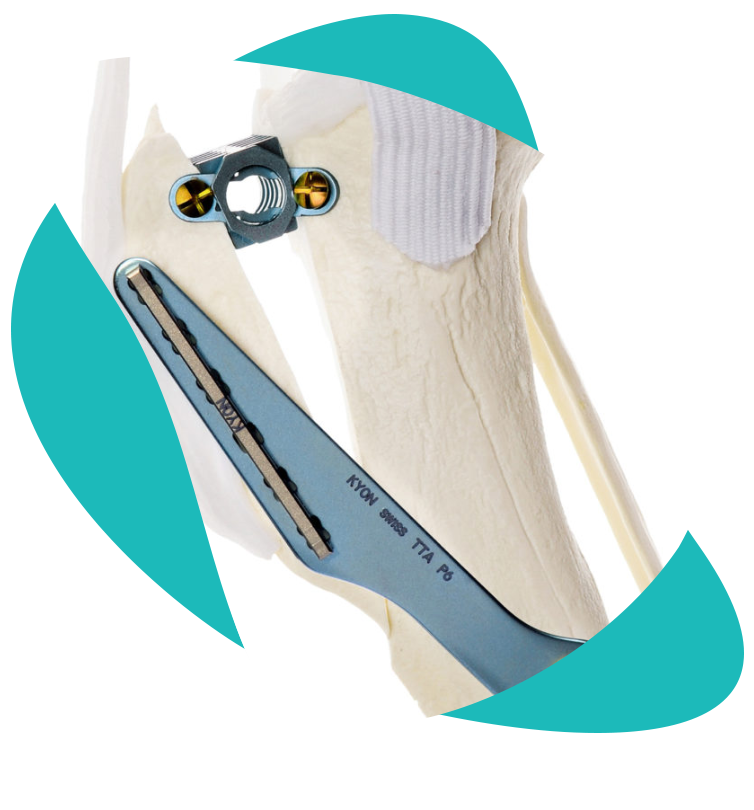Cranial Cruciate Ligament Repair Lateral Suture
The word cruciate means "to cross over" or "form a cross."
One ligament runs from the inside to the outside the knee joint and the other from the outside to the inside, cross over each other in the middle. Anterior cruciate ligament rupture is a common knee injury of canines.
The cranial cruciate ligament is one of several ligaments in the stifle (knee) that connect the femur (thigh bone) to the tibia (shin bone). The CCL has 3 main functions: (1) prevent cranial displacement of the tibia in relation to the femur (cranial drawer sign) (2) prevent hyperextension of the knee, and (3) prevent internal rotation of the tibia.
Extracapsular suture is used to replace torn CCL and restore knee joint functions. This is commonly done on small size pets under fifteen pounds of weight.TTA (Tibial Tuberosity Advancement)
Like the TPLO procedure, the TTA changes the mechanics of the stifle joint in order to counter-act the abnormal forces placed on the joint following injury to the CCL. This is surgical procedure designed for treating ACL ruptures and surgeons who have been performing TTA’s have been very satisfied outcome. In order to change the joint mechanics, a osteotomy is made in the tibial crest (cranial surface) where the patellar (knee cap) ligament attaches. This segment of bone is advanced a pre-determined distance and stabilized using a titanium plate and screws. Advantages of this procedure compared to the TPLO include a smaller, less invasive osteotomy in the bone at an area that is not directly involved in weight bearing, and potentially less complications. We have been performing TTA since July 2009 and have seen better comparable results to the TPLO. Pets tend to bear more weight on the limb earlier in the recovery period; however, strict exercise restrictions must be followed similar to the TPLO. VelVet Surgical uses exclusively KYON / TTA implants only, originally design for the procedure.TTA VS TPLO
The most often knee injury in the dog is tear of the Cranial Cruciate Ligament (CCL), also called the Anterior Cruciate Ligament (ACL). This injury can happen at any age or breed, but most lately occurs in middle aged, overweight, large breed dogs. This ligament can suffer a partial rupture, leading to instability of the knee. If this damage goes untreated, it most commonly leads to complete rupture and possibly damage to the medial meniscus of the knee. The meniscus acts as a pillow in the knee joint. Complete tears results in severe instability, commonly called Tibial Thrust, and internal rotation of the tibia, also called Pivot Shift. Untreated knee joints usually become very arthritic and painful. Torn Cranial Cruciate Ligament can only be corrected by surgery. There are numerous surgical corrections currently being performed. The most common are, External Capsular Repair, Tibial Plateau Leveling Operation (TPLO), and Tibial Tuberosity Advancement (TTA). The TTA, which is the newest procedure, and probably the best repair for most dogs. In a normal standing position a tendency for the lower end of the femur to slide backwards on the tilted tibial plateau, this is called tibial thrust. This force can be corrected by either cutting the Tibial Plateau and rotating it into a more flat position (TPLO) or by counteracting this force by changing the angle of the strong Patellar Tendon by advancing the Tibial Tuberosity (TTA). It has been proven that the TPLO technique can still allow rotational instability (Pivot Shift) and this may lead to the progression of arthritis as the dog ages. This Pivot Shift is not a issue with the TTA procedure because it results in more control of rotation by the large quadriceps muscle which pulls on the patellar tendon. 
